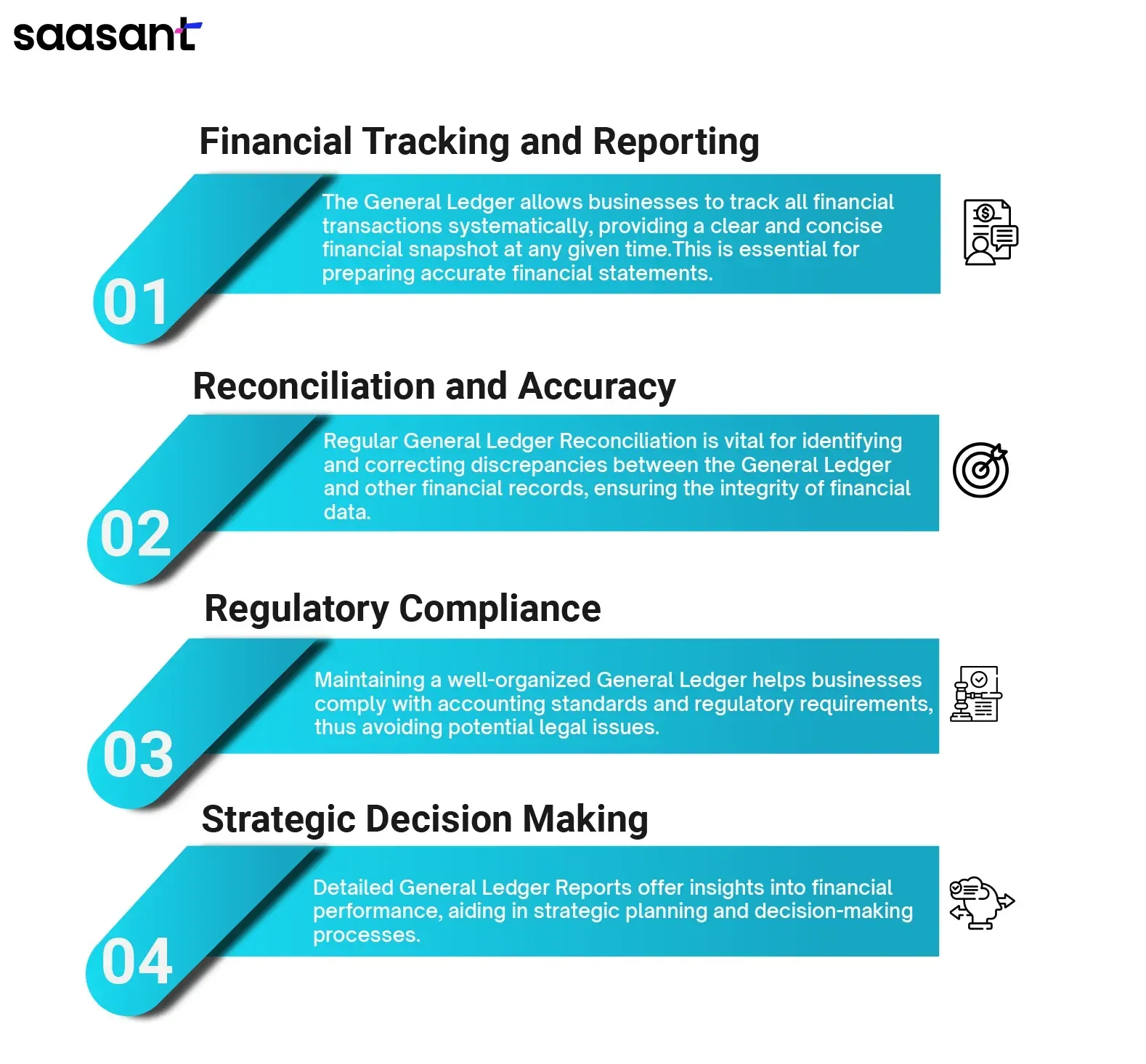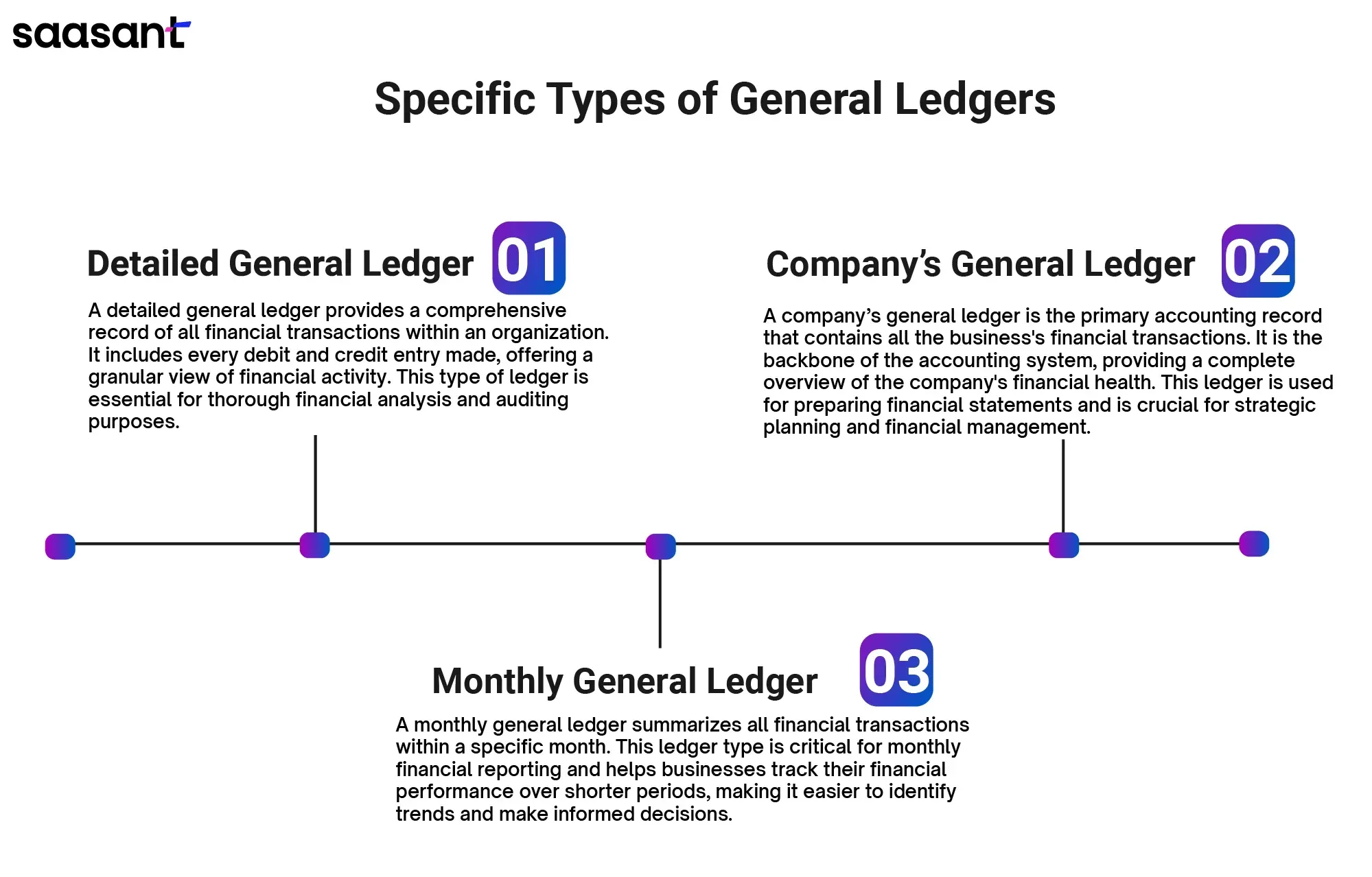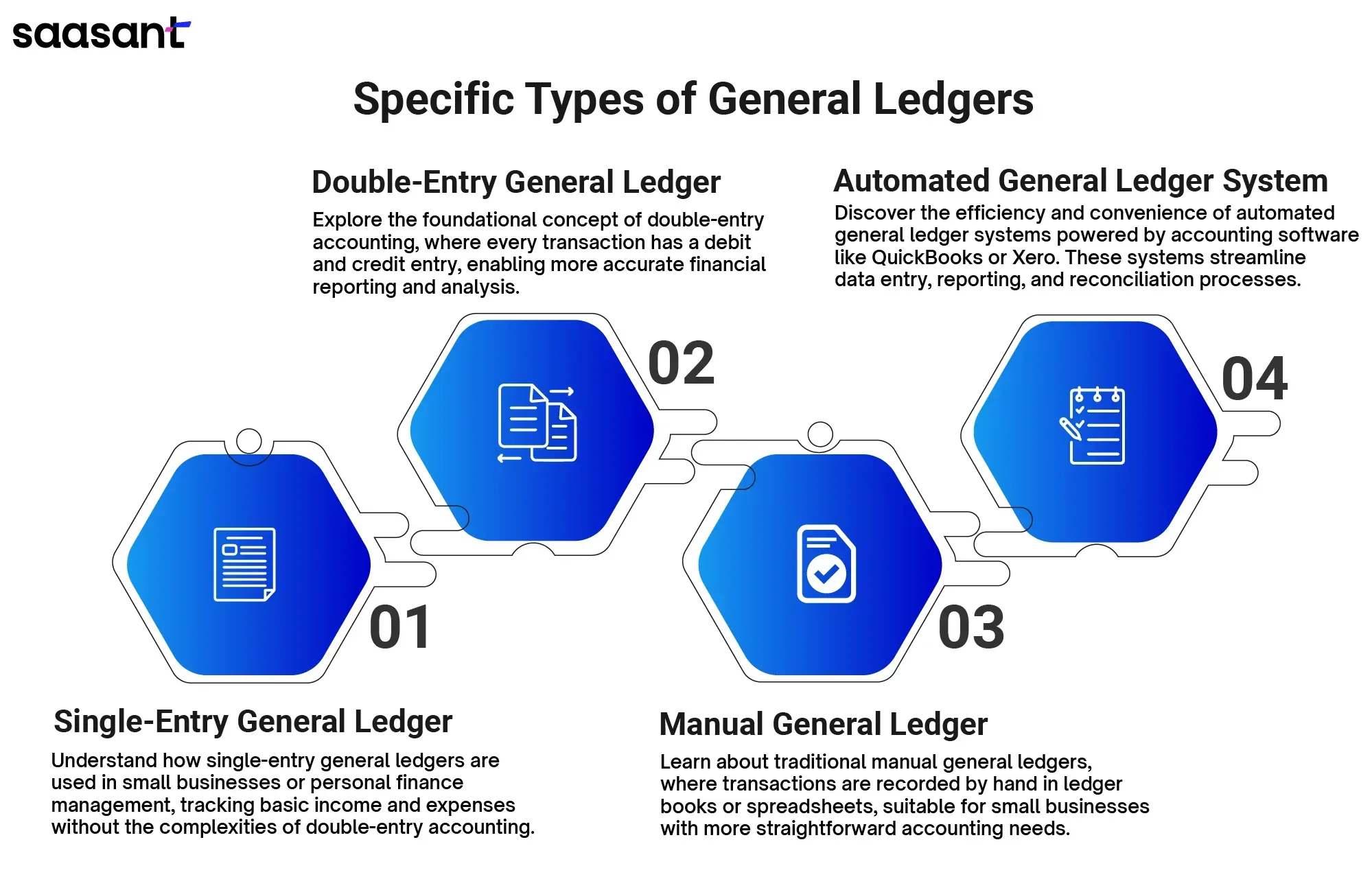What is a General Ledger? A Complete Guide for Businesses

The General Ledger is a fundamental component in accounting, serving as the comprehensive record of all financial transactions within an organization. This article delves into the definition of a General Ledger, its importance, and its purpose in accounting. It explores various aspects, such as General Ledger Software, General Ledger Systems, and best practices for General Ledger Management.
Contents
What is a General Ledger?
Importance and Purpose of a General Ledger in Accounting
Understanding General Ledgers
Components and Structure of General Ledgers
Types and Functions of General Ledgers
Exploring the Differences: General Ledger vs. Other Records
Exploring the Detailed Aspects of General Ledgers: Key Details, Variations, and Special Scenarios
Exploring Practical Examples and FAQs of General Ledgers: Understanding Types and Addressing Common Queries
Conclusion
FAQs
What is a General Ledger?
A General Ledger, often abbreviated as GL, is a complete record of all financial transactions conducted by a business. It includes detailed accounts that categorize financial data, such as assets, liabilities, revenue, expenses, and equity. Each financial activity is documented as a General Ledger Entry, contributing to the overall General Ledger Balance.
Importance and Purpose of a General Ledger in Accounting
The primary purpose of General Ledger Accounting is to provide a centralized repository where all financial data is aggregated and organized. This system ensures accuracy and completeness in financial reporting and is crucial for:
Financial Tracking and Reporting: The General Ledger allows businesses to track all financial transactions systematically, providing a clear and concise financial snapshot at any given time. This is essential for preparing accurate financial statements.
Reconciliation and Accuracy: Regular General Ledger Reconciliation is vital for identifying and correcting discrepancies between the General Ledger and other financial records, ensuring the integrity of financial data.
Regulatory Compliance: Maintaining a well-organized General Ledger helps businesses comply with accounting standards and regulatory requirements, thus avoiding potential legal issues.
Strategic Decision Making: Detailed General Ledger Reports offer insights into financial performance, aiding in strategic planning and decision-making processes.

The General Ledger is indispensable for accurate financial tracking and reporting. Whether you're managing a small business or a large enterprise, understanding the intricacies of General Ledger Accounting, utilizing the right General Ledger Software, and adhering to best practices are key to maintaining financial health and achieving regulatory compliance. From General Ledger Balance to detailed General Ledger Reports, every aspect plays a critical role in the overall financial ecosystem, making the General Ledger the backbone of practical accounting and financial management.
Understanding General Ledgers
Understanding general ledgers is fundamental to mastering accounting practices. The general ledger is the cornerstone of a company's financial records, providing a complete record of all financial transactions over the company's life. This blog will delve into a general ledger, its purpose, and how it functions within the accounting framework.
What is a General Ledger in Accounting?
In accounting, the general ledger is the central repository where all financial transactions are posted after being initially recorded in subsidiary journals. These transactions are summarized and categorized into various accounts, forming the backbone of the financial statements. Understanding general ledgers is crucial for accurate financial reporting and compliance with accounting standards.
What is a General Ledger Account?
A general ledger account is a specific record within the general ledger that tracks all transactions related to a particular item, such as cash, accounts receivable, or sales revenue. Each account in the general ledger contains detailed information, including the date, description, and amount of each transaction, which is crucial for understanding how general ledgers work.
What is a General Ledger Report?
A general ledger report is a detailed report that lists all the transactions recorded in each general ledger account over a specified period. This report provides a complete overview of a company's financial activities and is essential for financial analysis and decision-making. General ledger reports also help reconcile accounts and prepare financial statements.
What is a General Ledger System?
A general ledger system is software for automating financial transaction recording, tracking, and reporting. This system ensures accuracy, efficiency, and compliance with accounting principles. General ledger software integrates with other financial systems, streamlining the accounting process and enhancing financial management.
What is a General Ledger Code?
A general ledger code is a unique identifier assigned to each account in the general ledger. These codes facilitate the organization and tracking of financial transactions, making classifying and retrieving information easier. Using general ledger codes is a best practice in general ledger management, contributing to the system's efficiency and accuracy.
What is the Purpose of a General Ledger?
The primary purpose of a general ledger is to provide a comprehensive and accurate record of all financial transactions. This record is crucial for preparing financial statements, tracking financial performance, and ensuring compliance with accounting standards. Understanding the general ledger's purpose highlights its importance in a business's financial health.
What is a General Ledger Used For?
A general ledger is used for various purposes, including:
Financial Reporting: Preparing accurate financial statements such as the balance sheet, income statement, and cash flow statement.
Account Reconciliation: Ensuring all accounts are balanced and transactions are correctly recorded.
Budgeting and Forecasting: Analyzing historical data to project future financial performance.
Audit Trail: Providing a transparent and verifiable record of all financial activities for auditing purposes.
Components and Structure of General Ledgers
Understanding the components and structure of general ledgers is fundamental for effective accounting practices. This article will explore what is in a general ledger, provide a general ledger example, explain general ledger entries, and describe the format of a general ledger. By focusing on the general ledger components, general ledger structure, and the general ledger chart of accounts, you’ll understand how general ledgers function within a robust accounting system.
General Ledger Components
Assets: Resources owned by the business, such as cash, inventory, and property.
Liabilities: Obligations the business owes to others, including loans and accounts payable.
Equity: Owner's interest in the business, encompassing retained earnings and capital stock.
Revenues: Income from the business’s operations, like sales and service income.
Expenses: Costs incurred in earning revenue, such as salaries and utilities.
General Ledger Structure
The general ledger structure is designed to provide a clear and organized view of a business’s financial transactions. It is divided into several sections:
Account Name: The name of the specific account.
Account Number: A unique identifier for each account in the general ledger chart of accounts.
Debit and Credit Columns: These columns show the amounts debited or credited to each account.
Date: The date when the transaction occurred.
Description: A brief explanation of the transaction.
Balance: The running total of the account after each transaction.
General Ledger Account Types and Categories
General ledger account types are divided into two main categories: balance sheet accounts and income statement accounts.
Balance Sheet Accounts: Include assets, liabilities, and equity.
Income Statement Accounts: Include revenues and expenses.
General Ledger Example
Here’s a simplified general ledger example:
Date | Account | Description | Debit | Credit | Balance |
01/01/2024 | Cash | Initial Capital | $10,000 | $10,000 | |
01/05/2024 | Inventory | Purchase Inventory | $2,000 | $8,000 | |
01/10/2024 | Sales Revenue | Sale of Goods | $3,000 | $11,000 | |
01/15/2024 | Expenses | Utility Bills | $500 | $10,500 |
General Ledger Entries
General ledger entries involve recording financial transactions as debits and credits. The general ledger entry process is crucial for maintaining accurate financial records. Each transaction must be documented with the following:
Date: The specific day the transaction took place.
Account Names: The accounts impacted by the transaction.
Debit Amount: The value added to an account.
Credit Amount: The value deducted from an account.
Description: A brief note explaining the transaction.
What is a General Ledger Supposed to Look Like?
The general ledger layout should be clear and systematic, ensuring that all financial transactions are recorded accurately. The general ledger format typically includes columns for the date, account name, account number, description, debit, credit, and balance.
General Ledger Format
The general ledger format should facilitate easy tracking and reconciliation of transactions. Here’s a basic template:
Date | Account | Description | Debit | Credit | Balance |
01/01/2024 | Cash | Initial Capital | $10,000 | $10,000 | |
01/05/2024 | Inventory | Purchase Inventory | $2,000 | $8,000 | |
01/10/2024 | Sales Revenue | Sale of Goods | $3,000 | $11,000 | |
01/15/2024 | Expenses | Utility Bills | $500 | $10,500 |
Understanding the components and structure of general ledgers is vital for effective financial management. Knowing what is in a general ledger, familiarizing yourself with the general ledger entry process, and utilizing a clear general ledger format can ensure accurate and organized financial records. Implementing general ledger best practices and leveraging modern general ledger software will enhance your accounting efficiency and accuracy.
Types and Functions of General Ledgers
Understanding general ledgers' various types and functions is crucial for maintaining accurate financial records and ensuring smooth financial operations. This comprehensive guide will explore the specific types of general ledgers and the software tools used to manage them efficiently.
Specific Types of General Ledgers
Detailed General Ledger
A detailed general ledger provides a comprehensive record of all financial transactions within an organization. It includes every debit and credit entry made, offering a granular view of financial activity. This type of ledger is essential for thorough financial analysis and auditing purposes.
Monthly General Ledger
A monthly general ledger summarizes all financial transactions within a specific month. This ledger type is critical for monthly financial reporting and helps businesses track their financial performance over shorter periods, making it easier to identify trends and make informed decisions.
Company’s General Ledger
A company’s general ledger is the primary accounting record that contains all the business's financial transactions. It is the backbone of the accounting system, providing a complete overview of the company's financial health. This ledger is used for preparing financial statements and is crucial for strategic planning and financial management.

Software and Tools for General Ledgers
General Ledger in QuickBooks
QuickBooks is a popular accounting software that includes robust general ledger functionality. In QuickBooks, the general ledger tracks and organizes all the company's transactions into relevant accounts. This tool simplifies the management of financial records, making it accessible for small businesses and large enterprises alike.
General Ledger Report in QuickBooks
A general ledger report in QuickBooks provides a detailed view of all the financial transactions recorded in the general ledger. This report is essential for reviewing the business's financial activity, ensuring accuracy, and identifying any discrepancies that need to be addressed.
General Ledger in Bookkeeping
The general ledger is a critical tool for recording all business financial transactions. It categorizes these transactions into various accounts: assets, liabilities, revenues, and expenses. Maintaining a well-organized general ledger is fundamental to effective bookkeeping practices.
General Ledger on Quizlet
Quizlet is an educational tool for learning about general ledgers. It offers flashcards and study sets that cover key concepts, definitions, and functions of general ledgers. This resource benefits students and professionals looking to enhance their understanding of general ledger accounting.
By understanding the types and functions of general ledgers, businesses can enhance their financial tracking, reporting, and overall management, ensuring a solid foundation for growth and compliance.
Understanding and managing your General Ledger is crucial for maintaining accurate financial records and ensuring compliance with accounting standards. Saasant Transactions streamline your General Ledger processes by easily importing, exporting, deleting, and modifying all types of transactions into QuickBooks and Xero, saving time and enhancing accuracy. Its automated data entry eliminates manual data entry errors, and the app helps with practical reconciliation. With its comprehensive reporting, taking control of the general ledger is easier than ever before.
Exploring the Differences: General Ledger vs. Other Records
Various records play crucial roles in managing financial data and tracking transactions in accounting. The general ledger stands out as a cornerstone, but understanding its distinctions from other records is paramount for accurate financial management. This article delves into the disparities between the general ledger and other essential accounting records, highlighting their unique roles and functionalities.
General Ledger vs. Subsidiary Ledger:
While the general ledger provides an overview of all financial transactions within an organization, subsidiary ledgers offer detailed breakdowns for specific accounts, such as accounts receivable or accounts payable.
General Ledger vs. Trial Balance:
The general ledger contains all financial transactions, whereas the trial balance summarizes the accounts' balances to ensure accuracy and facilitate the preparation of financial statements.
General Ledger vs. Journal:
The general ledger aggregates transactions by account, whereas the journal records transactions chronologically before they are posted to the ledger.
General Ledger vs. Balance Sheet:
The general ledger provides detailed transactional data, while the balance sheet summarizes a company's financial position at a specific time, including assets, liabilities, and equity.
General Ledger vs. Income Statement:
While the general ledger contains transactional data, the income statement summarizes revenue, expenses, and profits or losses over a specific period.
General Ledger vs. Cash Book:
The general ledger records all financial transactions, while the cash book specifically tracks cash transactions, including receipts and disbursements.
General Ledger vs. Chart of Accounts:
The general ledger houses transactional data, while the chart of accounts provides a framework for organizing and categorizing accounts based on their nature and function.
General Ledger vs. Financial Statements:
The general ledger is the data source for financial statements, which present a company's financial performance and position.
General Ledger vs. Bank Statement:
The general ledger contains internal financial data, while the bank statement provides external records of a company's banking transactions.
General Ledger vs. Accounts Payable Ledger:
The general ledger encompasses all financial transactions, while the accounts payable ledger specifically tracks payments owed to suppliers or vendors.
General Ledger vs. Accounts Receivable Ledger:
Like the accounts payable ledger, the accounts receivable ledger tracks payments owed to a company by its customers or clients.
Understanding these disparities between the general ledger and other accounting records is essential for maintaining accurate financial records and facilitating informed decision-making within organizations. Whether tracking transactions, preparing financial statements, or managing cash flows, each record serves a distinct purpose in the broader financial management landscape.
Exploring the Detailed Aspects of General Ledgers: Key Details, Variations, and Special Scenarios
Understanding the intricacies of general ledgers is paramount for effective financial management in any business or organization. This comprehensive guide delves into the key details, variations, and special scenarios surrounding general ledgers, shedding light on their structure, functions, and unique considerations.
A. Key Details and Variations:
General Ledger Account: What exactly constitutes a general ledger account? Learn about the fundamental building blocks of general ledgers and how accounts are organized to track financial transactions.
Purpose of a General Ledger in Accounting: Explore the central role of general ledgers in accounting processes, including their significance in recording, summarizing, and reporting financial data for decision-making.
General Ledger for Businesses: Delve into how businesses utilize general ledgers to monitor financial performance, track expenses, manage budgets, and ensure regulatory compliance.
Appearance and Format of a General Ledger: Learn about the typical layout and format of a general ledger, including the columns, rows, and categories commonly found in ledger entries.
Credit on a General Ledger Trial Balance: Understand the concept of credits within general ledger trial balances and their significance in maintaining the balance between debits and credits.
B. Special Scenarios and Considerations:
Debit and Credit in a General Ledger: This section unpacks the distinction between debits and credits in general ledger entries, exploring their respective roles in recording transactions and maintaining accounting accuracy.
Unique Columns in General Ledger Forms: Discover the columns specific to general ledger forms that differentiate them from accounts payable and accounts receivable ledger forms, offering insights into specialized record-keeping requirements.
Purpose and Configuration of General Ledger Systems: Learn about general ledger systems' purpose-driven design and configuration, including customization options tailored to specific business needs and industry standards.
Exploring Practical Examples and FAQs of General Ledgers: Understanding Types and Addressing Common Queries
This part provides practical examples and addresses frequently asked questions (FAQs) related to general ledgers, offering insights into different types, common issues, and best practices. Whether you're new to accounting or seeking clarification on specific aspects of general ledgers, this resource aims to provide clarity and guidance.
Examples of Different Types of General Ledgers:
Single-Entry General Ledger: Understand how single-entry general ledgers are used in small businesses or personal finance management, tracking basic income and expenses without the complexities of double-entry accounting.
Double-Entry General Ledger: Explore the foundational concept of double-entry accounting, where every transaction has a debit and credit entry, enabling more accurate financial reporting and analysis.
Manual General Ledger: Learn about traditional manual general ledgers, where transactions are recorded by hand in ledger books or spreadsheets, suitable for small businesses with more straightforward accounting needs.
Automated General Ledger System: Discover the efficiency and convenience of automated general ledger systems powered by accounting software like QuickBooks or Xero. These systems streamline data entry, reporting, and reconciliation processes.

Conclusion
In conclusion, understanding general ledgers is essential for effective financial management in any business or organization. The general ledger is the cornerstone of accounting, providing a comprehensive record of all financial transactions and ensuring accuracy in financial reporting. From tracking income and expenses to preparing financial statements and facilitating strategic decision-making, the general ledger plays a vital role in a business's financial health and success.
Businesses can gain valuable insights into their structure, functions, and unique considerations by delving into the essential details, variations, and unique scenarios surrounding general ledgers. Whether exploring different types of general ledgers or addressing common questions and issues, this guide aims to provide clarity and guidance for navigating the complexities of financial record-keeping and reporting.
Ultimately, by understanding the intricacies of general ledgers and implementing best practices in their management and utilization, businesses can optimize their financial processes, enhance accuracy and integrity, and drive long-term success. With a solid understanding of general ledgers and their practical applications, companies can confidently navigate the ever-changing landscape of financial management and achieve their goals with clarity and precision.
FAQs
What is the difference between a general ledger and a trial balance?
Difference between General Ledger and Trial Balance:
The general ledger is a complete record of all business financial transactions, categorized by accounts. It includes details like date, description, debit, and credit amounts.
The trial balance is a list of all ledger accounts with their respective debit and credit balances, used to ensure that debits equal credits in the accounting system. It's a snapshot of the financial position at a specific point in time.
How do I reconcile discrepancies in my general ledger balances?
Identify discrepancies by comparing ledger balances with source documents, transaction records, and bank statements.
Investigate the causes of discrepancies, such as errors in recording transactions, duplicate entries, or missing entries.
Adjust ledger entries to rectify errors and ensure balances reconcile accurately.
Reconcile regularly to maintain accuracy and detect errors promptly.
What are the best practices for organizing and structuring a general ledger?
Establish a logical chart of accounts tailored to your business needs.
Group similar accounts together for more straightforward navigation and reporting.
Use consistent naming conventions and numbering systems for accounts.
Document accounting policies and procedures to ensure consistency in ledger entries.
Regularly review and update the general ledger structure to reflect changes in business operations.
How can I ensure the accuracy and integrity of my general ledger data?
Implement internal controls to prevent errors and fraud, such as segregation of duties and regular audits.
Train staff on proper accounting procedures and data entry protocols.
Perform regular reconciliations and reviews to identify discrepancies and errors promptly.
Utilize accounting software with built-in validation checks and error detection features.
Back up ledger data regularly to prevent loss or corruption of information.
What role does the general ledger play in financial statement preparation?
The general ledger is the primary data source for preparing financial statements such as the balance sheet, income statement, and cash flow statement.
It aggregates all financial transactions and account balances, providing a comprehensive view of the company's financial position and performance.
Financial statements are generated by summarizing and analyzing the information stored in the general ledger, ensuring accuracy and compliance with accounting standards.
How do I handle adjustments and corrections in the general ledger?
Identify the reason for the adjustment, such as errors, accruals, or prepayments.
Determine the appropriate account and period for the adjustment.
Record the adjustment in the general ledger, ensuring it follows accounting principles and standards.
Document the adjustment with clear explanations and supporting documentation.
Reconcile affected accounts and review financial statements to ensure accuracy after the adjustment.
What are the critical components of a comprehensive general ledger entry?
Date: The date of the transaction.
Description: A brief description of the transaction.
Debit Amount: The amount recorded on the debit side of the account.
Credit Amount: The amount recorded on the credit side of the account.
Account Number: The account affected by the transaction.
Reference Number: Any reference number or identifier associated with the transaction.
Supporting Documentation: Copies of invoices, receipts, or other relevant documents.
How can I integrate my general ledger with other accounting systems or software?
Choose compatible accounting software that supports integration with your general ledger system.
Set up data mapping to ensure seamless transfer of information between systems.
Test the integration process to verify the accuracy and reliability of data transfer.
Train staff on how to use integrated systems effectively.
Regularly monitor and troubleshoot integration issues to maintain data integrity.
Tags
Read also
Import Journal Entries into QuickBooks Online: Step by Step Guide
How to Delete Journal Entry in QuickBooks Online
How to View Journal Entries in QuickBooks Online
How to Create a Manual General Ledger with Excel?